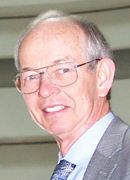
Please Note: The content on this page is not maintained after the colloquium event is completed. As such, some links may no longer be functional.
Jim Geringer
Wyoming Governor (1995-2003)
ESRI/Director of Policy and Public Sector Strategy
GIS: Connecting People, Places and Policy in a Competitive World
Wednesday, April 13, 2011
Building 3 Auditorium - 11:00 AM
(Coffee and cookies at 10:30 AM)
Everything we do is somewhere. Every decision we make has an effect on something or someone. Nothing stands alone. No decision should be made in isolation. GIS directly contributes to increased productivity and improved services across many sectors, public and private.
The Internet and other technologies will change tremendously in the next 10 years. A more important question is, how will they change us? How will the concept of cloud computing and web services dramatically change how we compete in the future?
We are a data driven society. We risk being overwhelmed by too much data or even the lack of or wrong kind of data. We need a way to turn the right data into actionable information. Policy makers, senior executives and planners must deal with the pressure of daily decisions while keeping longer range strategy clearly in mind. They are increasingly turning to geographic information systems technology as a strategic tool for changing how they develop options and arrive at decisions. Enterprise GIS is key to a solid information infrastructure, enabling management to make informed choices and to better assess the impact of decisions.
GIS engages through visualization, but the real business value is more than a map. It's about interrelationships and the rich information modeling and sophisticated data management that location referenced information can provide. Today's call for greater accountability, performance measurement and transparency in government and business require the capabilities that GIS can provide.
We have a clear need to be able to access, integrate, analyze, model and use spatial data from disparate sources to enable decisions by heads of state as well as by individuals.
That requires compatibility across jurisdictions to discover, acquire, exploit and share geographic information vital to the decision process - in other words, through an enterprise approach.
But even in this era of networked computers, the habits of the past continue to prevent users from finding, sharing and using essential geographic information. We must reach across traditional boundaries.
Today's knowledge economy cannot compete without greater collaboration to resolve difficult or conflicting goals. Location based services are more popular than ever, from basic viewers to complex modeling served up through web-enabled services. I will discuss the trends and technologies that are making geospatial applications more popular and useful than ever.
How well are we preparing the next generation to meet global competition? Perhaps our greatest threat is not our competition but our own complacency.
Jim Geringer received a B.S. in Mechanical Engineering from Kansas State University, then spent 10 years active and 12 years reserve service in the US Air Force working on unmanned space programs for both the Department of Defense and NASA. Projects included remote sensing satellites, the GPS system (NAVSTAR), Mars Viking Lander, the NASA HEAO and others.
Upon leaving active duty, he served as contract administrator for the construction of a 1700 megawatt coal-fired electric power generation plant near Wheatland Wyoming, then took up agricultural pursuits along with serving in the Wyoming Legislature from 1983 to 1994, including six years each in the House and the Senate.
Geringer served two terms as Wyoming Governor, from 1995-2003, during which he focused on improving education through standards, accountability and technology, modernizing Wyoming's economic base to extensively include technology, changing how natural resource agencies among state, federal and local governments worked together, establishing community-based health and family services programs and implementing strategic planning and information systems. While in office, he chaired of the Western Governors' Association, the Education Commission of the States and served on a variety of national and regional education and technology initiatives.
He is a member of the Committee on America's Climate Choices under the National Academies, served on the Mapping Sciences Committee under the National Research Council; current member of the Community Resilience Committee under Oak Ridge National Laboratories; NASA PNT Advisory Committee for the Global Positioning Satellite System; Western Interstate Energy Board; Vice-Chair of the Association of Governing Boards for Colleges and Universities; Operation Public Education; the Board of Governors of the Park City Center for Public Policy; Board member of NatureServe; co-chair of the Policy Consensus Initiative; Current Chair of the Board of Trustees, Western Governors University.
Jim joined Environmental Systems Research Institute (ESRI) in the summer of 2003 as Director of Policy and Public Sector Strategies to work with senior elected and corporate officials on how to use geospatial technology for place-based decisions in business and government.
His recent keynotes include conservation, education, energy, climate change, health care, health data standards, alternative energy, education policy, natural resources, homeland security, disaster response, the importance of government services enabled through web services, information infrastructure, e-government planning and building consensus on divisive issues.
Governor Geringer and his wife Sherri have five children and ten grandchildren. They reside in Cheyenne, Wyoming.
IS&T Colloquium Committee Host: Curt Tilmes
Sign language interpreter upon request: 301-286-7040
